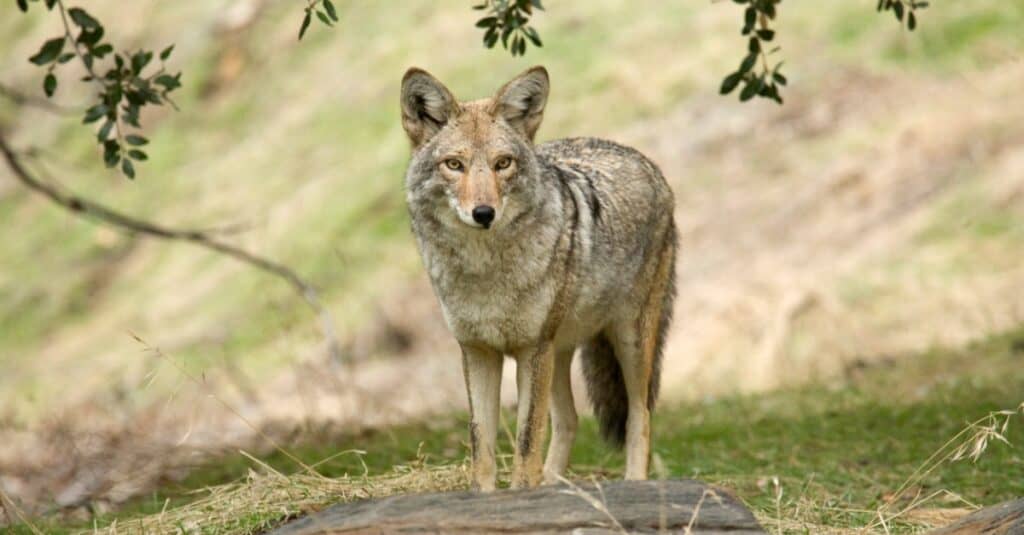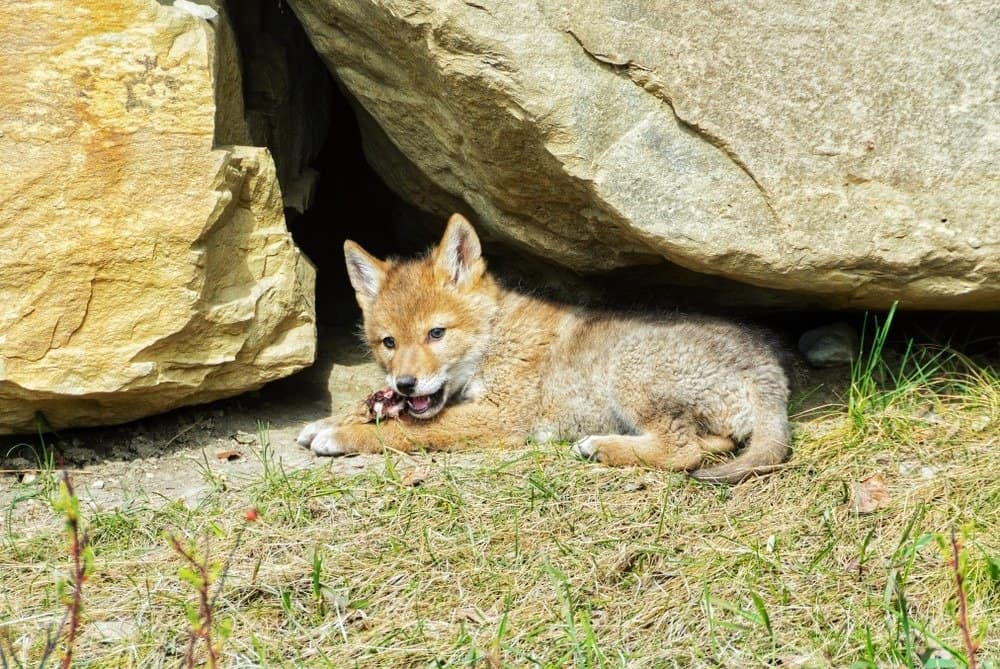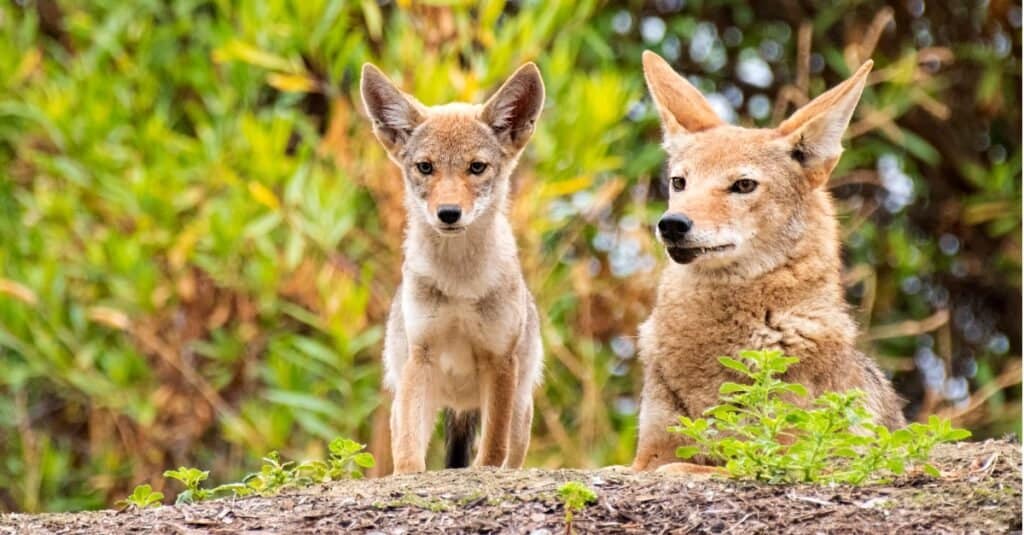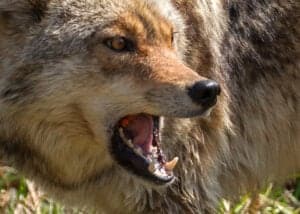
Coyotes live in grasslands, deserts, woods, cities, and suburbs. They are even in major cities such as Los Angeles.
©iStock.com/Fabiomichelecapelli
No doubt you’ve either read about coyotes in your area, heard stories, or seen them for yourself. These canines used to live in wide grasslands and deserts, but now wander forests, mountains, and cities of North America. This species has even made its way into the suburbs of many major cities including Los Angeles. But, where do they hide their dens? Keep reading to learn more about where these cunning creatures live and how they build their dens.
Where Do Coyotes Live? Coyote Dens

Coyotes typically only build or make dens to birth their pups and protect them. They will use resources such as tree stumps or old burrows from other animals to hide.
©Muriel Lasure/Shutterstock.com
Coyotes exclusively use dens during pup season; otherwise, they sleep in the open or undercover. Coyote dens can be discovered anywhere that is easily hidden.
Dens can be a hollowed-out tree stump, a rock outcrop, or an existing raccoon, skunk, or another medium-sized predator burrow. Coyotes will also excavate their own dens. They prefer a protective cover like plants or trees, and a drainage slope.
What Does A Coyote Den Look Like?

Mothers will move their young from den to den to keep them safe from predators.
©FRAYN/Shutterstock.com
To build a coyote den, both parents may dig on sandy hillsides or steep banks. Brush often conceals the entryway. The chamber is reached via a tunnel dug from a few feet to fifty feet under the hillside. The mother will nurse and protect her pups in the chamber three to six feet below the surface.
Sometimes coyotes will expand other animals’ burrows. They may also use hollow logs, rock heaps, or culverts as a den. Even when denning in suburbs, coyotes pick spots with little human activity. If disturbed, the parents may relocate the litter.
Mothers often transfer their young from den to den to keep them safe or reuse the same den year after year. However, in increasingly populated regions, coyotes may choose to create dens near houses, roads, or even parking lots.
Where Do Coyotes Live? List of Common Habitats

Coyotes live in cities, suburbs, woods, deserts, grasslands, swamps, and tundras.
©iStock.com/roclwyr
Coyote dens and hideouts have been discovered in many places such as:
Cities
Surprisingly cautious towards humans, urban coyotes have become quite bold. These scavengers find safe green spots of land in parks and golf courses. If they run out of food, they expand their domain. City coyotes live peacefully if they have enough food and shelter, even in a tiny area.
Suburbs
Coyotes live in cities, towns, and rural/semi-urban locations. Since many Americans are going green, this animal is more likely to reside near farms. They can readily prey on pets here. The coyote diet requires them to dwell near crops or fields.
Woods
Historically, coyotes lived in woodlands. However, they are born in the wild and can adapt to any environment. Most coyotes seek cover in deep forests with plenty of food. They may dig tunnels and cover them with brush to disguise their den in the woods.
Deserts
Coyotes are undeniably the most adaptive creature. Many coyotes live in the Arizona Desert. The desert’s hot sun, sand, and chilly night breeze don’t bother them.
Grasslands
Coyotes, like most wild animals, find refuge in grasslands. They inhabit all of North America’s grasslands. Similarly, many of these species reside and breed at Yellowstone National Park.
Swamps
Eastern and coastal North Carolina wetlands have coyote territories. The adaptive creature establishes territories in wetlands. But they establish territories away from alligators.
Tundra
Surprisingly, Coyotes can swim well. They thrive in the tundra, a huge treeless area of North America. They also live in the Arctic tundra.
Safety Advice

Coyote attacks are rare. However, it is important to always be on alert, and contact authorities when necessary.
©iStock.com/Fabiomichelecapelli
Although they are natural predators, coyotes aren’t out to get people. We can happily coexist with them wherever we live if we understand their motivations, how to keep them away, and how to protect ourselves and our pets. For example:
- Don’t feed coyotes and keep food out of their reach.
- Keep pet food indoors and rubbish out of sight.
- Avoid letting tiny creatures (like squirrels) eat near bird feeders. They can attract coyotes.
- When not in use, clean grills.
- Dispose of roadkill and other deceased animals.
- Don’t let your pets alone outside at night.
- Put up fencing and motion sensor lights to keep predators away from your pets.
- Provide enclosures or secure spaces for any outdoor animals.
- Haze coyotes if you spot them. That includes yelling at them, swinging your arms, hurling stuff toward them (not at them), and/or spraying them with a hose, if available.
Remember that although coyotes can become dog-like towards humans, they are still wild animals that will defend their territory in an instant. Therefore, If you find a coyote’s den, be cautious and never approach a coyote or its pup.
Did you know?
coyotes are quite human-like. Just like us, they have a large family structure, eat a wide variety of foods, and live in many settings. They mate for life with a single partner and both parents help raise the kids.
They are incredibly gregarious animals who love their family. They will even carve off a section of their area for one of their offspring if they are unable to find suitable land. They playfully communicate through vocalizing and scent-marking and are very smart creatures.
The photo featured at the top of this post is © iStock.com/roclwyr
Thank you for reading! Have some feedback for us? Contact the AZ Animals editorial team.





